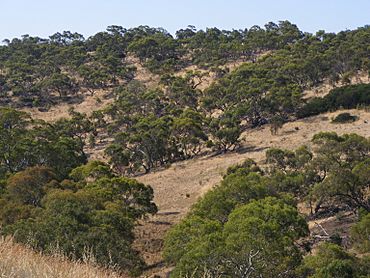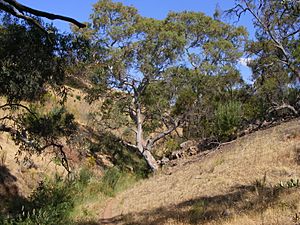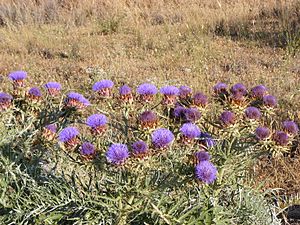Cobbler Creek Recreation Park facts for kids
Quick facts for kids Cobbler Creek Recreation ParkSalisbury East, South Australia |
|
|---|---|
|
IUCN Category III (Natural Monument)
|
|

Cobbler Creek Recreation Park
|
|
| Established | 26 October 1989 |
| Area | 2.66 km2 (1.0 sq mi) |
| Managing authorities | Department for Environment and Water |
| Website | Cobbler Creek Recreation Park |
| See also | Protected areas of South Australia |
Cobbler Creek Recreation Park is a special protected area in South Australia. It's about 266 hectares (that's like 657 acres!) and is located about 19 kilometers north of Adelaide's city center, in a suburb called Salisbury East. This park used to be part of the land belonging to the Kaurna Aboriginal people. Later, after European settlers arrived, it was used for farming until it became a park in 1989.
Today, the park acts as a green space between the areas of Golden Grove and Salisbury. It has dams to help control floods and is a really important place for people to enjoy nature and for protecting local plants and animals. Main roads surround the park, and a four-lane road even cuts through it.
Contents
What is Cobbler Creek Recreation Park Like?
Cobbler Creek Recreation Park is a large protected area, covering 266 hectares. It's about 19 kilometers north of Adelaide's city center, right in the suburb of Salisbury East. The park is bordered by Bridge and Smith roads, and Green Valley Drive. A big road called The Grove Way goes right through the park, but don't worry, there's a special underpass so people can easily walk between the two parts of the park.
The park is open for everyone to visit. It has three marked walking trails and even two old ruins you can explore. You can find the remains of William Pedler's home, called "Trevalsa," and another old house known as "Teakles House" along one of the trails. There aren't many public buildings, but you'll find benches, signs, and picnic tables. "Kelway House," which was once part of a farm, is now used as an office for the park's staff.
Weather and Landscape in the Park
The park sits right where the dry northern Adelaide Plains meet the wetter Mount Lofty Ranges. The weather here is measured at a nearby airport, and it gets about 465 millimeters of rain each year. In winter, the temperature usually ranges from 6.2 to 15.6 degrees Celsius. In summer, it's warmer, from 16.5 to 29.7 degrees Celsius.
Because of the risk of flooding after heavy rain, the park has dams along its waterways. However, these waterways are often dry for most of the year. The park's land changes from gently sloping on the west side to quite hilly on the east. The lowest point is 70 meters above sea level near Bridge Road, and it rises to 215 meters at a high point in the park's southeastern corner. The flat areas on the west have red-brown soil, while other parts have different types of soil like Terra Rosas and fine-textured mallee soils.
Cobbler Creek itself starts in the hills near Golden Grove and joins with Slate Creek before it enters the park. This creek helps collect stormwater from the Tea Tree Gully area as it flows through farms and suburbs. After leaving the park, the creek goes through housing areas, into wetlands, and eventually reaches the Barker Inlet.
Cobbler Creek Recreation Park is recognized as an IUCN Category III protected area. This means it's important for protecting natural features.
How the Land Was Used Before
After European settlers arrived in South Australia, the land that is now Cobbler Creek Recreation Park was used for farming. One of the first farmers was William Pedler III, who came from Cornwall in 1838. He and his wife Elizabeth started farming here. William was a shoemaker in Cornwall and Adelaide. From his farm in Salisbury, he made shoes and boots for teamsters (people who drove teams of animals) who were transporting ore to Burra.
William Pedler first bought 66 acres of land at Cobbler Creek in 1850. He later added more land, making his farm 279 acres. He passed the farm down to his oldest son, William IV, who continued to farm there with his family. William III's job as a shoemaker is actually how both the creek and the park got their names! Pedler's farm was on the flatter, western side of the park near Bridge Road.
Later, part of the park became a farm known as "Kelway Park." The old homestead (farmhouse) from Kelway Park is still in the park's south-west. In the 1800s, people from Salisbury used this area for Sunday school picnics. They would set up swings, bring food and water, and enjoy games and music.
Even though investigations haven't found direct proof of land use before European settlement, the park is part of the traditional lands of the Kaurna Aboriginal people. It's likely that the Kaurna used this area during winter for food and shelter, and then moved closer to the coast in the summer to escape the heat.
History of the Park
In 1962, a government report suggested that the area of the park should be kept as open space for the future. There were ideas to build a golf course or other sports facilities there. The golf course idea came up again in 1981 and in the park's management plan in the 1990s.
The Government of South Australia bought the park land in 1970. This was part of a plan to save open spaces for recreation. The park's location was chosen to create a green buffer zone between the existing suburbs of Salisbury and the planned Golden Grove development. The State Planning Authority owned and managed the land until 1982, when control moved to the National Parks and Wildlife Service.
Cobbler Creek was officially declared a recreation park in 1989. At that time, some of the land was still being leased for farming. A law called the Golden Grove Indenture Act (1984) made the government promise to build certain roads to the new suburb of Golden Grove. Because of this law, in June 1987, the government approved building The Grove Way. This road is a four-lane divided road that connects different areas. Construction started in September 1988 and finished in 1990.
Today, Cobbler Creek Recreation Park is managed and looked after by both the City of Salisbury and the Department of Environment, Water and Natural Resources. A group of volunteers called "Friends of Cobbler Creek" was started in 1990. They work with park rangers to help improve and maintain the park.
Plants and Animals in the Park
While some parts of the park have been cleared (because of past farming), other areas have grasslands, river red gum trees, and mallee box trees. The park is home to some of the last remaining mallee box grassy woodland in Adelaide. Among these woodlands, you can often find plants like the blue-flowering flax lily.
Most of the lower, western parts of the park were cleared for pasture (grazing land) and cropping until the early 1970s. While there are still some native plants on higher ground, many introduced grasses and weeds now grow in the undergrowth. Native grasses like kangaroo grass have been planted as part of the park's efforts to bring back native plants. Many of the introduced grasses dry out in summer, which can be a fire risk. To help prevent fires and protect nearby homes, the park has annual controlled burns, especially around its edges. These burns also help native plants grow better than the introduced weeds.
The park has many different native plants, including quandong, ruby saltbush, desert cassia, weeping pittosporum, and umbrella wattle.
The number of native animals has gone down a lot because of past farming. Now, the introduced rabbit is very common. You might see reptiles like Eastern bearded dragons, White's skinks, eastern brown snakes, and sleepy lizards; a total of twenty different reptile species have been seen in the park. Birds like Black-shouldered kites and nankeen kestrels hunt over the grasslands. You can also spot red-rumped parrots and crested pigeons feeding on the ground, and wattlebirds, musk lorikeets, noisy miners, and honeyeaters in the flowering gum trees and along the creeks. The park is also home to a small group of the worm-like and vulnerable Flinders Ranges worm-lizard.
Fun Things to Do
Recreational activities are encouraged in Cobbler Creek Recreation Park. There are picnic facilities available, and you can walk your dog as long as it's on a leash. The park has three named walking trails: Mai Tappa, Babbler, and Porosa. These trails mostly follow the park's management tracks. The trails pass by the park's old ruins, and signs along the way tell you about these historical spots and natural sights.
Mountain bike riding used to be against the rules in the park, and illegal trail bike riding was common. However, since 2013, special trails have been built that can be used by both walkers and mountain bike riders.






